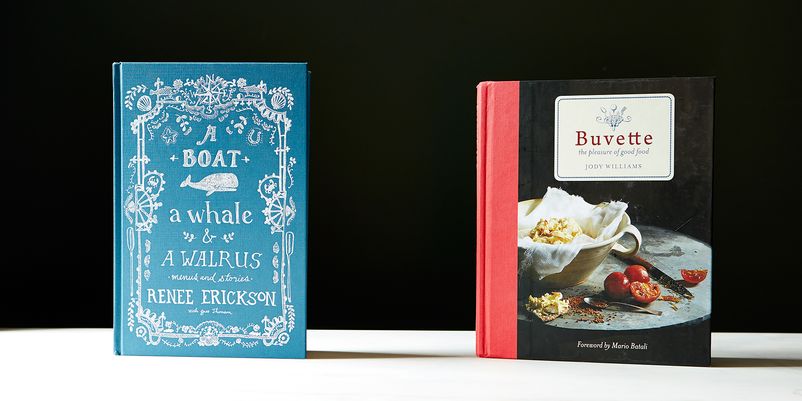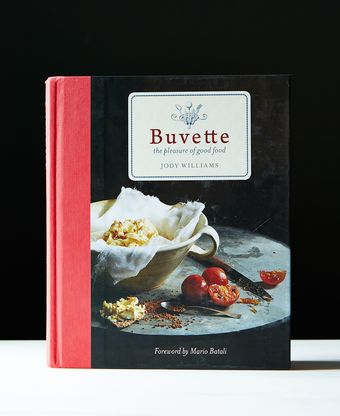I’m a member of a cookbook book club with my friends Lukas, Sadie, and Ruth that meets once a month for a potluck dinner exclusively drawn from the recipes in one book. We started meeting because we had a mutual interest in cooking recipes from Laurie Colwin’s two food memoirs; we wanted to find out whether her spinach jalapeño casserole really deserves to be cooked hundreds of times (it does), and whether her ideas about eggplant, pot cheese, and fermented black beans are as vile as they sound (they are!). In the years that followed, we’ve branched out, cooking both from classic books we remember from childhood and from buzzed-about new ones.
Our most successful dinners to date have been from Jerusalem and The Edna Lewis Cookbook. I still think about those meals when I’m hungry, especially the juices from Edna Lewis’s smothered chicken mingling on my plate with her stewed tomatoes and fresh peas in cream. Our worst dinner ever was from Cooking For Mr. Latte, which I blame not on the recipes, but on how nervous we were to cook for Amanda, who was our guest that night. We choked, figuratively and then almost literally, when we tried to eat our undercooked rice, gamey duck, gritty salad, and dry cake.
The cookbook book club has taught me to look at cookbooks in a different way: I still enjoy them as armchair trips to fancy restaurants or exotic locales -- especially if their prose is great -- but mostly, I’m looking at the recipes to see which ones I’d want to bring to one of our dinners. What seems so irresistible that I can’t wait to see how it tastes? What might be a great component of a memorable meal? And -- okay, to be totally honest -- what isn’t going to take me trips to multiple boroughs, $50, and three days to accomplish? And that's what I thought about when I received A Boat, A Whale & A Walrus and Buvette for the Piglet.
The first is a fantastic cookbook to read. Renee Erickson and her co-writer Jess Thomson have done a great job of capturing the Seattle-specific flavors that define Erickson’s four restaurants there, all of which emphasize seasonality and local ingredients like salmon, blackberries, oysters, herring, spot prawns, mackerel, crab, and all kinds of local, in-season fruits and vegetables. In an unusually comprehensive resources section, A Boat, A Whale & A Walrus lists Erickson's preferred sources for butter, yogurt, crème fraîche, heirloom lentils, preserved lemons, walnut oil, and honey vinegar. She finishes her dishes with Jacobsen salt, because it’s “relatively local.” In an introductory section titled “Methods,” she advises that “if you’re going to follow many of the recipes in this book to the letter, it will be convenient to have a friend with a boat.”
Flipping through the chapters, which are organized into seasonal party menus, I tried to find a recipe that begged to be cooked. And I found a lot of food that looked incredibly appealing, but that had a high barrier to entry. A brunch menu included scones with homemade jam, house-smoked salmon (“should be easy to do at home with a small countertop smoker”), and pork crépinettes, homemade sausages wrapped in lacy webs of pork caul fat that need to rest for two or three days to let their flavors meld. The resulting brunch looked gorgeous and luxurious and indulgent, like something I would love to be served in a restaurant. Making it at home, though, would be like hosting Thanksgiving times ten.
I finally found my way into the cookbook through the sections of simpler recipe-ettes that bookend the menus. These blue-backgrounded pages focus on specific ingredients, divided by season. They're more like formulas than recipes, and they are rock-solid: The carrot-parsnip and potato-leek soups I made were both buttery, balanced, and perfect. Erickson isn’t shy about the power of cream and crème fraîche to make eating your vegetables less about virtue and more about indulgence; there’s a recipe for lacinato kale gratin that’s basically just three bunches of sliced kale topped with three cups of heavy cream and eight ounces of sliced cheddar cheese. That’s a little wild and crazy for me, but I did love a refreshing, old-fashioned yet innovative salad that combined thinly sliced celery root, walnuts, celery leaves, and pomegranate seeds with a heavenly dressing of crème fraîche, preserved Meyer lemon, and poppy seeds. I’d love to see more of this kind of recipe from Erickson: innovative combinations of relatively ordinary foods that feel special and indulgent yet aren’t once-a-year expensive or hard to procure and prep.
Buvette, written by chef Jody Williams along with cookbook-cowriting superstar Julia Turshen, is also a cookbook based on dishes served at her restaurants. (Williams owns two Buvettes -- one in New York's West Village, and the other in Paris.) Her philosophies and most favored flavors aren’t so different from Erickson’s; both chefs are inspired by classic bistro fare and seasonal, high-quality ingredients -- and neither stints on good olive oil or fresh cream and butter. Instead of being divided by season, though, Buvette has sections devoted to different times of day.
Mornings are about eggs: baked and poached, draped with ramps or asparagus or paper-thin ham, whipped into omelettes or enriching the batter of crêpes and brioches. Afternoons bring hearty, meaty salads with mustardy dressings, rich bistro sandwiches like pan bagnat and croque monsieur, and more delicate vegetable preparations that involve shaved shards of roots and cheeses mingling in gentle vinaigrette. A section on jambon et fromage gives valuable advice on shopping for the best ham and cheese (like plan on 3 ounces of the latter per guest), plus a recipe for Buvette’s famous pesto di Parma, an indulgent spread made of prosciutto ends, Parmigiano-Reggiano, sage leaves, and olive oil that requires a meat grinder and is a great justification for owning one. Evenings bring heartier vegetable sides, meat, fish, slow-cooked lentils, and cassoulet. The book closes with recipes for the only two desserts Buvette serves: mousse au chocolat and tarte tatin, plus a few bonus simple sweets.
It didn’t take me long to figure out which recipes I’d cook first from Buvette. I always love to see leeks vinaigrette on a menu but I’ve never made it at home, and I had just spotted a bunch of tiny apples at the grocery store, so I made a relatively quick weeknight dinner of the leeks and Roasted Heirloom Apples Filled with Pork Sausage. It was all delicious, though I wish I’d heeded the headnote and served the apples with something heartier on the side, like lentils or potatoes. Next time.
In deciding between the two books, I had to think of which one would be a better pick for cookbook club. Though I could imagine us having a great time poring over A Boat, A Whale and A Walrus’s pretty pages, I knew immediately that for cooking, we’d choose Buvette. I can already guess which recipes my fellow cookbook club members will gravitate toward: Ruth won’t be able to resist making the chocolate mousse, while Sadie, who’s a great baker, might be tempted to try the tarte tatin. Lukas, who adores vegetables, might braise some artichokes -- Williams’ favorite vegetable -- with anchovies, mint, and wine to make carciofi alla Romana, in their “gorgeous elixir of a broth.” And if I’m hosting the meal, I’ll likely make the simple poulet roti, and maybe one of the risottos if I’m feeling ambitious. I’ll shop wisely for ham and cheese, and maybe hunt down my KitchenAid’s meat grinder attachment to make that pesto di Parma. This round goes to Buvette.




41 Comments
Also, Buvette is a feature in a Bon Appetit's Travel Issue from last year so anyone curious about her recipes that isn't ready to spring for the book yet should try those first. It was making 2 or 3 of those recipes with spectacular results that made me confident that the cookbook would be wonderful.